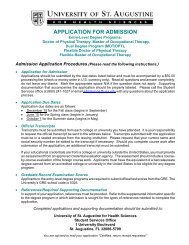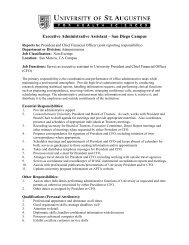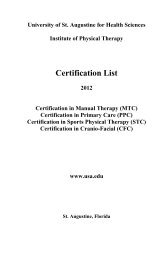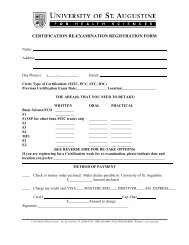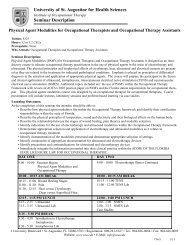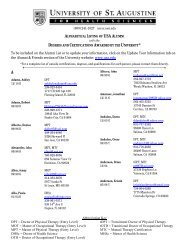OCT 6497 - Capstone Project 2 Hours: 4This course is an integration <strong>of</strong> the knowledge and skills appropriate to a student’s specialty area. Byapplying theory and practice, students have the opportunity to explore an approach to the delivery <strong>of</strong>occupational therapy services. Under advisement <strong>of</strong> a faculty member, the student will complete acommunity service project or a clinical research project. The project will involve designing themethodology, implementing the project, and collecting the data to measure the project’s effectiveness.The results will be shared through a publishable article or oral presentation.OCT 6498 – Clinical Integration Internship Hours:Variable credit up to 8ExperienceThis internship is designed to integrate the coursework taken during the OTD program with clinicalexperience. By applying theory and practice, students have the opportunity to observe, per<strong>for</strong>mevaluations and interventions with a client/patient population. <strong>St</strong>udents will demonstrate clinicalreasoning through journaling and documenting their experiences. Under advisement <strong>of</strong> a faculty advisor,the student will write and present a case report.OPA 5110 – OPA Pr<strong>of</strong>essional Issues I Hours: 2This course begins with history <strong>of</strong> American Society <strong>of</strong> Orthopedic Physician Assistants and their role inthe health care delivery system. Other topics include HIV/Aids, Medical Errors, Infection Control, andHIPAA regulations. Pr<strong>of</strong>essional behaviors, communication skills, interpersonal skills and Patient CareModels will be presented with emphasis on clinical application. <strong>St</strong>udents will practice taking subjectivepatient and family histories, conducting medical record reviews, writing treatment, progress anddischarge notes and a Functional Outcome approach to documentation. In the later half <strong>of</strong> the course,students will complete several one-day observations <strong>of</strong> orthopaedic practice.OPA 5120 – OPA Pr<strong>of</strong>essional Issues II Hours: 2This course discusses ethical and medico-legal related issues associated with clinical practice. Topicsinclude ethics and ethical principles, cultural diversity, abuse, and some psychological concepts related tohandling difficult patients and chronic conditions. In addition, risk management, safety, and qualityassurance, functional assessment tools, reimbursement and Medicare are covered. <strong>St</strong>udents will practicethe use <strong>of</strong> electronic documentation.OPA 5125C – OPA Lab Procedures Hours: 2This lab/lecture course covers the indications, contraindications, preparations, applications and removal<strong>of</strong> extremity and trunk casting, bracing, splinting, wrapping, and taping. Lower and upper extremityamputations and prosthetics are also covered, including types <strong>of</strong> prosthetics, fitting, patient care,utilization, and analysis. In addition, extremity and spinal traction are covered as well as the care <strong>of</strong>wounds and post-operative surgical sites through the use <strong>of</strong> sterile technique, suturing, dressings,debridement, and patient/family education. Safety is emphasized throughout this course.OPA 5132C – OPA Orthopaedics I Hours: 5This lecture and lab course is a presentation <strong>of</strong> the foundations <strong>of</strong> medical orthopaedics. It includes tissuereactivity, surgical and non-surgical musculoskeletal disorders common through out the life span <strong>of</strong> thejoints <strong>of</strong> the upper and lower extremity and spine. These disorders include those resulting from trauma,joint and s<strong>of</strong>t tissue conditions, infection, neoplasms and neuromuscular, metabolic, vascular andsystemic diseases. Aspects <strong>of</strong> basic imaging related to these areas are also included. <strong>St</strong>udents learn to doa through orthopaedic examination and clinical management approaches <strong>for</strong> different dysfunctions willbe discussed and practiced through a mock clinic <strong>for</strong>mat. Patient/family education and safety areemphasized104
OPA 5134C – OPA Orthopaedics II Hours: 4This course covers invasive and non-invasive treatment skills associated with musculoskeletaldysfunctions arising from neurological, orthopaedic or disease conditions. Some areas covered includetreatment <strong>for</strong> s<strong>of</strong>t tissue and peripheral nerve injuries, spinal disorders, reflex sympathetic dystrophy,dislocation, fractures, joint – ligament – tendon reconstruction, arthritis, and hyper/hypo mobility.<strong>St</strong>udents learn to per<strong>for</strong>m foley catherization, phlebotomy/IV insertion, aspirations and injections.Specific general interventions and exercise methods utilized by occupational and physical therapists arediscussed, as is patient /family education. Safety and appropriate documentation is emphasizedthroughout this course.OPA 5151C – Clinical Neuroscience Hours: 2Clinical neuroscience is a lecture and lab course in which students receive an overview <strong>of</strong> theneuroanatomical and neurophysiological foundations <strong>for</strong> understanding normal function, dysfunction andclinical interventions. The etiology, signs and symptoms, and medical intervention <strong>of</strong> the more commonneurologic pathologies will also be included.OPA 5200 – OPA Surgery Hours: 4This course covers indications, contraindications, safety, instrumentation and equipment, and steriletechniques associated with surgery. In addition, the knowledge and physical skills needed to assist withorthopaedic surgical procedures as well as pre-operative preparation and pre- and post- operative careand patient management are covered. The surgical procedures covered involve the upper and lowerextremities and spine and include reduction procedures on bone and joints; reconstruction surgery onjoints and ligaments; repairs <strong>of</strong> muscles, tendons, and ligaments; transfers <strong>of</strong> tendons and nerves;amputations and the removal <strong>of</strong> <strong>for</strong>eign bodies; and arthroscopic procedures. <strong>St</strong>udents also learn properpositioning <strong>of</strong> the patient <strong>for</strong> surgery, how to monitor anesthesia and how to close and care <strong>for</strong> traumaticwounds and surgical incisions. <strong>St</strong>udent are instructed about potential medical errors that can occur withsurgery and how best to avoid these. Observation <strong>of</strong> video and live surgeries, along with lab simulationswill augment this course.OPA 5351 – OPA Orthopaedic Pharmacology Hours: 3This course provides a clinical perspective <strong>of</strong> the general concepts <strong>of</strong> pharmocokinetics andpharmacodynamics related to the practice <strong>of</strong> orthopaedic medicine. It describes classes and specific drugs<strong>for</strong> pain and inflammation, rheumatoid arthritis, osteoarthritis, skeletal muscle, infections, as well ascentral nervous system drugs, cholinergic and adrenergic drugs, cardiovascular drugs and endocrinedrugs. Some gastrointestinal and respiratory are also described. These descriptions include: a) clinicaluses, b) therapeutics effects and mechanisms, c) side effects, and contraindications. The effects <strong>of</strong>exercise, aging and other factors on pharmacodynamics are included when relevant to clinical practice.OPA 5700 - Wellness and Prevention Hours: 2This course will present the concept <strong>of</strong> Wellness as a foundation to the improvement <strong>of</strong> health caredelivery services and interventions. It will allow the students to investigate their own personal wellnessand to internalize the in<strong>for</strong>mation, to become role models <strong>of</strong> Wellness in the health care pr<strong>of</strong>ession.Additionally, the concepts <strong>of</strong> Wellness will be applied to the practice <strong>of</strong> rehabilitation, making relevantthe content to the student’s roles as future pr<strong>of</strong>essionals. The course will include specific objectivespromoting wellness and patient education to maintain health and prevent disease by empowering clientswith holistic lifestyle choices by identifying barriers to change, goal setting and problem-solving. Inaddition, a special emphasis will be on health promotion and disease prevention on a macro level, whichanalyzes policies and procedures that engender concern <strong>for</strong> individuals as they operate in society.105
- Page 4 and 5:
San Diego sunsetSt. Augustine and o
- Page 6 and 7:
STUDENT SERVICES ..................
- Page 8 and 9:
DOCTOR OF EDUCATION (EdD) .........
- Page 10 and 11:
San Marcos, California CampusSt. Au
- Page 12 and 13:
certification. A felony conviction
- Page 14 and 15:
In 1996, the Institute of Occupatio
- Page 16 and 17:
Learning Resource CenterThe Univers
- Page 18 and 19:
ENTRY-LEVEL PHYSICAL THERAPY, OCCUP
- Page 20 and 21:
SUMMER 2012 TRIMESTERApril 30Intern
- Page 22 and 23:
TRANSITONAL DOCTOR OF PHYSICAL THER
- Page 24 and 25:
BOARD OF TRUSTEESMr. Joseph Taylor,
- Page 26 and 27:
• Graduate Record Examination sco
- Page 28 and 29:
• The right to inspect and review
- Page 30 and 31:
San Marcos Campus: The full-time DP
- Page 32 and 33:
Transitional Doctor of Physical The
- Page 34 and 35:
Scholarships are awarded to the ent
- Page 36 and 37:
San Marcos Campus - The entry-level
- Page 38 and 39:
Director, will determine if the sub
- Page 40 and 41:
The student obtains and submits the
- Page 42 and 43:
Good Academic Standing StatusPrior
- Page 44 and 45:
Appeal letters should address:• T
- Page 46 and 47:
TUITION AND FEESThe University of S
- Page 48 and 49:
Currently enrolled students who are
- Page 50 and 51:
TRIMESTER IITrimester HoursHSC 5122
- Page 52 and 53:
TRIMESTER IITrimester HoursHSC 5122
- Page 54 and 55:
Dual Degree Option (MOT and DPT)The
- Page 56 and 57:
TRIMESTER IXTrimester HoursPHT 5824
- Page 58 and 59:
Mission StatementThe mission of the
- Page 60 and 61:
TRIMESTER XTrimester HoursPHT 5140C
- Page 62 and 63:
TRIMESTER IITrimester HoursHSC 5122
- Page 64 and 65: TRANSITIONAL DOCTOR OF OCCUPATIONAL
- Page 66 and 67: Delivery of transitional OTD Course
- Page 68 and 69: BSC 6101 Application of Motor Contr
- Page 70 and 71: TRANSITIONAL DOCTOR OF OCCUPATIONAL
- Page 72 and 73: Delivery of OTD CourseworkCourses i
- Page 74 and 75: Advanced Practice CoursesBSC 6001 F
- Page 76 and 77: TRANSITIONAL DOCTOR OF PHYSICAL THE
- Page 78 and 79: • For the speciality clinical tra
- Page 80 and 81: Craniofacial TrackCourse # Course T
- Page 82 and 83: TRANSITIONAL DOCTOR OF PHYSICAL THE
- Page 84 and 85: • If a Clinical Residency is chos
- Page 86 and 87: Craniofacial TrackCourse # Course T
- Page 88 and 89: DIVISION OF POST-PROFESSIONAL STUDI
- Page 90 and 91: Complete a minimum of one (1) cours
- Page 92 and 93: TUITION AND FEES - Doctor of Health
- Page 94 and 95: A credentialing evaluation from an
- Page 96 and 97: COURSE DESCRIPTIONSPrefix key:BSC -
- Page 98 and 99: scientific literature needed to gui
- Page 100 and 101: EDF 7125 - Organizational Leadershi
- Page 102 and 103: HSA 6101E - Health Services Adminis
- Page 104 and 105: In addition, the course will addres
- Page 106 and 107: individual reasoning and acquired k
- Page 108 and 109: HSC 7300 - Imaging for Physical and
- Page 110 and 111: OCT 5005 - Clinical Reasoning Hour:
- Page 112 and 113: OCT 5802 - Fieldwork IA Hour: 1This
- Page 116 and 117: Assignments and course work will em
- Page 118 and 119: elective area of orthopaedic examin
- Page 120 and 121: learning, and skill acquisition. Ne
- Page 122 and 123: PHT 5805 - Practicum II Hours: 2Thi
- Page 124 and 125: anatomical principles for the enhan
- Page 126 and 127: sixth day. Prerequisites are BSC 60
- Page 128 and 129: practice where they will have the o
- Page 130 and 131: DIVISION OF PROFESSIONAL EDUCATIONC
- Page 132 and 133: Sports Physical Therapy Certificati
- Page 134 and 135: Advance Payment ProgramThe Advance
- Page 136 and 137: CLINICAL ORTHOPAEDIC RESIDENCYThe u
- Page 138 and 139: ORTHOPAEDIC MANUAL PHYSICAL THERAPY
- Page 140 and 141: FACULTY FOR CONTINUING PROFESSIONAL
- Page 142 and 143: Robert Stanborough, PT, Assistant P
- Page 144 and 145: Matthew Daugherty, PT, OTR/L, Instr
- Page 146 and 147: Marcia Kessack, RN, Adjunct Faculty
- Page 148 and 149: Marilyn Miller, PT, Associate Profe
- Page 150 and 151: Robert Stanborough, PT, Assistant P
- Page 152: Clinical ExcellenceThrough Graduate



